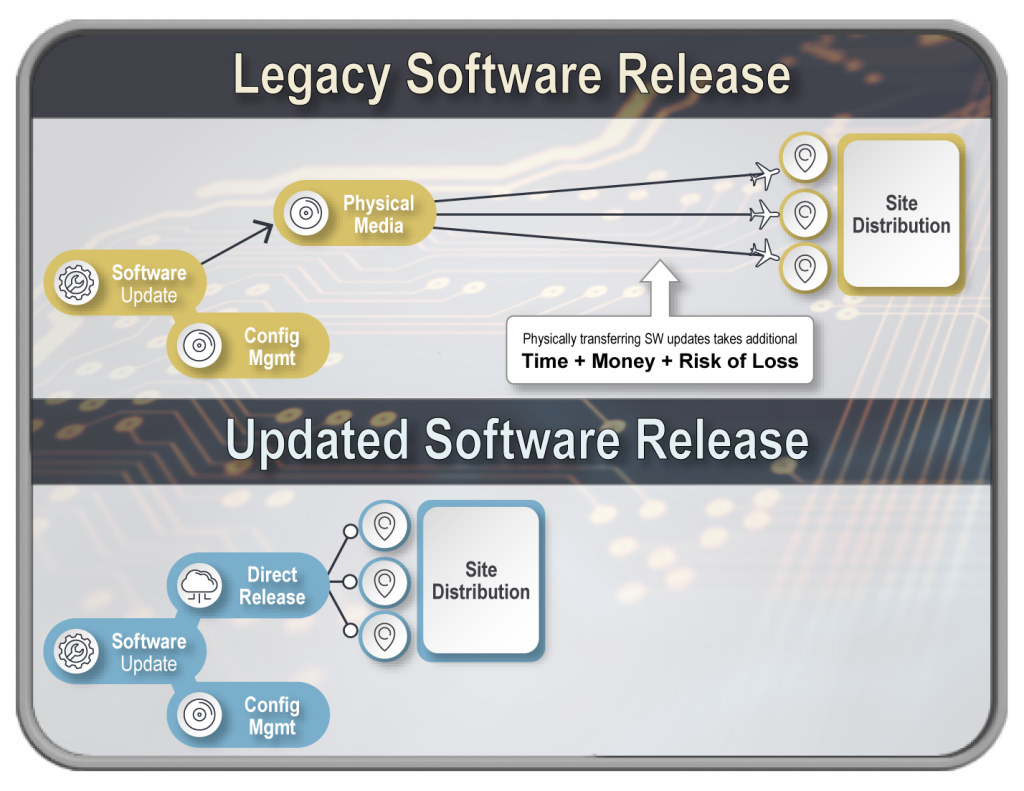
IN BRIEF: First Lt. Kelsea Krauss, assigned to 4th Air Defense Artillery Regiment, briefs Soldiers on an upcoming exercise during Saber Strike 22 at Kazlu Ruda Air Base, Lithuania. The direct release of digitized software puts new capabilities into the hands of Soldiers in as little as half an hour. (Photo by Staff Sgt. Clinton Thompson, 118th Mobile Public Affairs Detachment)
Leveraging existing tools to expedite software capabilities to the warfighter.
by Justin Neal and Scott Gill
The emphasis on providing capability to the warfighter faster and more efficiently has long been a focus of acquisition reform and policies. However, many of our legacy processes and tools for taking that capability from final design to deployment have either underperformed or been underutilized.
The 2019 National Defense Authorization Act (NDAA) formally added the Army Integrated Air and Missile Defense (AIAMD) to the DOD Agile Pilot Program. This not only meant that the software development approach had to evolve, but that the software deployment processes had to adapt to support this Agile development approach because existing, traditional methods of software delivery were not keeping up with the faster development.
Physically transferring the digital data slowed down the entire process, so the engineers at Integrated Fires Mission Command (IFMC) decided to implement a new, digital distribution process using an existing life cycle management tool.

SUCCESSFUL TEST: The Army Integrated Fires Mission Command and Soldiers of the 3rd Battalion 43rd Air Defense Artillery Regiment conduct a successful missile flight test on Nov. 17 with the Integrated Air and Missile Defense Battle Command System at White Sands Missile Range, New Mexico. (Photo by Darrell Ames, PEO Missiles and Space)
The Windchill Product Lifecycle Management (PLM) software from PTC, a Boston-based computer software and services company, is a data management tool that allows real-time collaboration between geographically distributed teams. After a new release process was approved, the IFMC team began using Windchill PLM to securely deliver software to Soldiers.
Historically, these software deliveries required physical media (i.e., compact discs, Blu-ray) shipments to theater, taking days and often weeks for media to arrive, risking media damage and loss. The direct release of digitized software to the warfighter greatly reduces the time and cost to get software updates to the field, putting new capabilities into the hands of our Soldiers in as little as half an hour.
The IFMC Project Office has leveraged the digitization and deployment of Forward Area Air Defense Command and Control software upgrades and Information Assurance Vulnerability Alert updates to the warfighter both inside and outside the continental United States, including both the U.S. Pacific Command and the U.S. Central Command areas of responsibility via Windchill PLM.

A NEED FOR SPEED: Physically transferring the digital data slowed down the entire process. Engineers at Integrated Fires Mission Command (IFMC) used Windchill Product Lifecycle Management to securely deliver software to Soldiers. (Graphic by IFMC.)
MATCHING CADENCE
Software media created for and by the IFMC Project Office is digitized. The digitization of tangible software media enables both a permanent archive in Windchill PLM and provides transmission capability to external partners. Once the media is digitized, it is uploaded to IFMC’s Windchill PLM-controlled product data library, which serves as the permanent software repository for the IFMC Project Office. When directed by leadership, the digitized software can be copied to external, access control project folders accessible to partners, such as the fielded units, who will receive notifications once new software is added to their inbox. These project folders also serve as a permanent data library cloud, enabling the warfighter to download additional copies as needed, eliminating the requirement to keep hard copies.
“[This] has enabled me to quickly receive updates to operational software,” said Chief Warrant Officer 2 John Bearth, 3rd Combat Aviation Brigade. “[It] improves timeliness and availability by electronically delivering software, security updates and patches to unit-level system administrators to help increase software readiness and protect against cybersecurity threats.”
Currently the IFMC Project Office is using Windchill PLM for unclassified software; however, digitization and transmission capability exist for classified software as well. The Secure Internet Protocol Router Network (SIPRNet), Army Research Lab Safe Site, and Secret Defense Research and Engineering Network are currently being used to disseminate classified software to support ongoing software deployments, but each distribution method has its limitations. In order to better support ongoing and future IFMC software deployments, Windchill PLM and other classified deployment capabilities are in the process of implementation across as many areas of operation as possible.

QUICK DELIVERY: Integrated Fires Mission Command implemented a new, digital distribution process to securely deliver software to Soldiers. (Photo by Sgt. 1st Class Claudio Tejada, 94th Army Air and Missile Defense Command)The exercise allowed service members to hone and refine the steps they would take in the event of a crisis or contingency while executing integrated air and missile defense operations supporting the Pacific theater operation plans.
CONCLUSION
Rapid software development requires equally fast software delivery to provide relevant capability. As the Army and its programs focus on the bigger picture of rapid acquisition and rapid capability deployment, those tasked with executing these programs must consider the best process to streamline delivery of capability to the warfighter. Integrated Fires Mission Command’s use of an existing tool has opened new opportunities for rapid software deployment and hopes to continue growing this capability for future programs and uses.
Lessons learned from the Forward Area Air Defense Command and Control and Information Assurance Vulnerability Alert transmissions to the warfighter will enable the IFMC Project Office to enhance the life cycle sustainment of the future Integrated Battle Command System-fielded units, joint IBCS integration efforts, and IBCS international customers. The capability needs of the Army show no signs of decreasing, so IFMC will continue to lean forward in all aspect of improving rapid capability delivery tools, techniques, and processes.
For more information contact PEO Missiles and Space at (256) 876-0714 or go to www.msl.army.mil.
JUSTIN NEAL is an engineer assigned to the Integrated Fires Mission Command Project Office within the Program Executive Office (PEO) for Missiles and Space, serving as the technical data management lead. He holds an M.S. in systems engineering and a B.S. in mechanical engineering from the University of Alabama in Huntsville. He is DAWIA certified Practitioner in engineering and is a member of the Army Acquisition Corps.
SCOTT GILL is a systems engineering and technical assistance (SETA) contractor and configuration management lead from Intrepid Inc. supporting the Integrated Fires Mission Command Project Office within PEO Missiles and Space. He holds an MBA from Trident University International and a BBA from the University of Cincinnati. He is Project Management Professional (PMP) certified.







